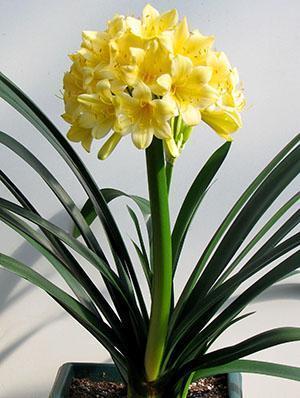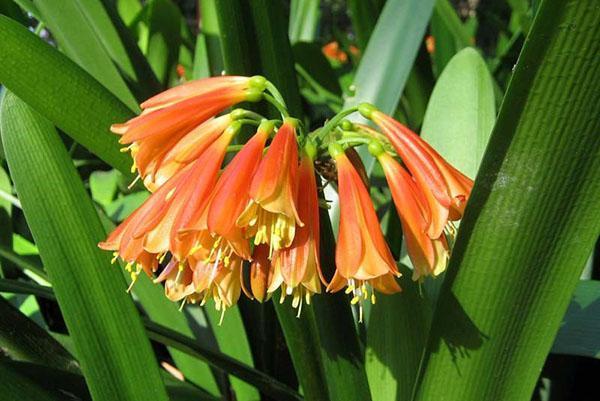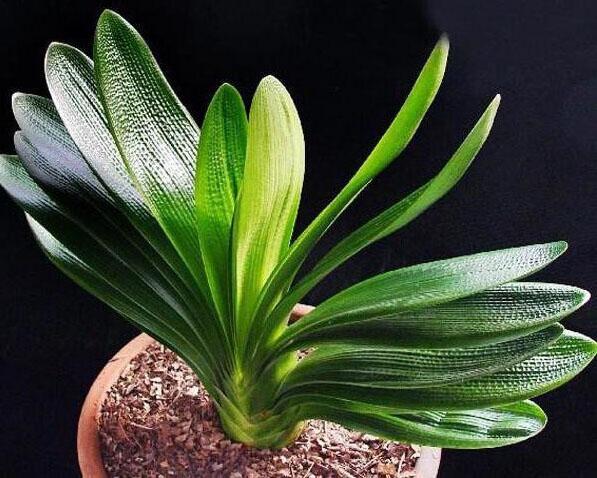We grow clivia at home and provide proper care
 Once an amateur saw the winter flowering of clivia in the photo, home care of any complexity will not stop you from acquiring a miracle. A relative of the hippeastrum, it does not have a bulb and does not need a rest period. Herbaceous plant does not require special care, blooms in winter. Beautiful clivias and cinnabar clivias are grown in the home interior.
Once an amateur saw the winter flowering of clivia in the photo, home care of any complexity will not stop you from acquiring a miracle. A relative of the hippeastrum, it does not have a bulb and does not need a rest period. Herbaceous plant does not require special care, blooms in winter. Beautiful clivias and cinnabar clivias are grown in the home interior.
Features of the maintenance and care of clevia at home
The large leaves are oblong and resemble skin. They come out of the root, tightly clasping each other, forming a rosette. The crown is a flower arrow with many flowers, similar to lilies, collected in a single bouquet. Clivia blooms in winter, some varieties emit a secondary arrow in summer.

The plant in the milky juice contains the poison lycorin! Accidental ingestion of juice can cause severe paralysis in children and pets. The less body weight, the greater the consequences of poisoning.
Read also the article: streptocarpus care and growing from a leaf!
Agrotechnics of clivia
With good care of the clivia, it will create a rosette of leaves and discard a peduncle with a lot of bells. For this to happen, you need to groom and undead the flower.
Place the clivia so that nothing, except for a light openwork shading, blocks the light. For this, a stand is made near the windows. If there is not enough light, the leaves are crushed, the clivia will refuse to bloom. The size in height and the number of bells in a bouquet directly depend on the conditions for keeping the flower.
In summer, it is undesirable to keep the plant on the windowsill also because it needs a temperature of 17-20 degrees for the appearance of a peduncle. 19-25 degrees is considered comfortable for a flower.
The dormant period for clivia begins after flowering, the care at this time is special. Artificial limitation will allow the plant to mobilize strength for the release of a new peduncle. Each time you need to reduce watering, temperature for several weeks, do not apply fertilizers until a new arrow appears on the plant. After that, create comfortable conditions for development. With an arrow length of 15-17 cm, the plant is watered with warm water, but watering is increased gradually. It is from the arrow that the peduncle will subsequently come out.
 When caring for clivia at home, it is very important to organize the correct watering and fertilization of the plant. Water for irrigation settles for several days, during the dormant period, moisture is scarce, and later during the month, the flow rate is increased gradually, using only warm water. The root is fleshy, the probability of decay is high. Therefore, watering is moderate, only when the top layer of the earth dries up. The drainage should work well to keep the water out of the pot.
When caring for clivia at home, it is very important to organize the correct watering and fertilization of the plant. Water for irrigation settles for several days, during the dormant period, moisture is scarce, and later during the month, the flow rate is increased gradually, using only warm water. The root is fleshy, the probability of decay is high. Therefore, watering is moderate, only when the top layer of the earth dries up. The drainage should work well to keep the water out of the pot.
Top dressing is applied twice a month, during the period of intensive vegetation, in summer. In this case, a balance should be observed between dressings that stimulate flowering and a set of leaf mass.
If foliage grows violently, then flowering will be weak and short-lived. You need to find a middle ground for the clivia flower when caring at home. Usually, organic liquid fertilizers and formulations for flowering houseplants are alternated. For each flower, the dosage is selected according to the appearance of the plant.
They also enter the dormant period gradually, reducing watering for a month.
Transplant, reproduction of clivia
First of all, you need to find the right soil. It is simple, sod earth, leaf humus are mixed in equal proportions and sand is added with a fifth of the composition. You need to transplant the clivia by carefully transferring it to a prepared bed in a large container. In this case, the drainage layer should be at least 4 cm, the soil is poured onto the sides gently, compacted with light shaking. If the roots are damaged during transplantation, they begin to rot in the soil.
Most often, clivia is propagated by children from a mother plant during transplantation. They grow from the sides. Those plants that have already formed 4-6 leaves are ready for independent life. They are carefully separated and seated in a small container in the composition of sand and leaf humus. After two years, the plant should bloom.
 When leaving at home, clivia is seated with children, as in the photo.
When leaving at home, clivia is seated with children, as in the photo.
You can get young seedlings from seeds obtained at home or purchased. For reproduction, seeds are taken from soft ripe berries. Sowing is carried out to the school. Seedlings appear in a month and a half. Seedlings are planted in separate cups after the appearance of real leaves.
Diseases and pests of clivia and the fight against them
Any plant disease is caused by deviations in the conditions of detention. Therefore, at the first sign, it is necessary to conduct an analysis, compare the life of the plant with the recommended care for the clivia.
Thus, the gradual yellowing of the lower leaves is a physiologically inevitable factor. The aging leaves must be removed. But if there is massive yellowing, it can be:
- improper watering;
- irregular feeding;
- depletion of the plant in which the fruits are ripening;
- moving the flower to a new location.
When overflowing, root decay may occur and the plant must be transplanted immediately. Cut the roots to healthy tissue and disinfect the plant, and change the soil. The dried tips of the leaves suggest this.
The plant does not bloom most often due to the warm content during the dormant period. And underdeveloped peduncles are obtained for the same reason. Another reason for the lack of color on a recently transplanted plant may be the extra pot volume. Therefore, the transplant is done only when the roots climb out into the drainage hole and are visible from above.
The leaf plate is covered with dry spots from the sun's rays directly falling on the leaf.
 But it is much worse if red stripes appear on the leaves. This is the work of the fungus, the causative agent of the disease stagonosporosis. Disease of amaryllis bulbs, but occurs in clivia. The mushroom propagates with planting material. Control measures - treatment with copper fungicides.
But it is much worse if red stripes appear on the leaves. This is the work of the fungus, the causative agent of the disease stagonosporosis. Disease of amaryllis bulbs, but occurs in clivia. The mushroom propagates with planting material. Control measures - treatment with copper fungicides.
Fungicides must also be treated when the leaf blade begins to dry out from the edge along its entire length.
Usually scale insects or mealybugs can settle on a weakened plant. Wiping with a soap-alcohol solution will save you from scabbards. The smell of kerosene is harmful to worms. And if there are a lot of pests, you will have to apply Actellik.
These are some simple methods for caring for clivia to help preserve the beauty of the plant.